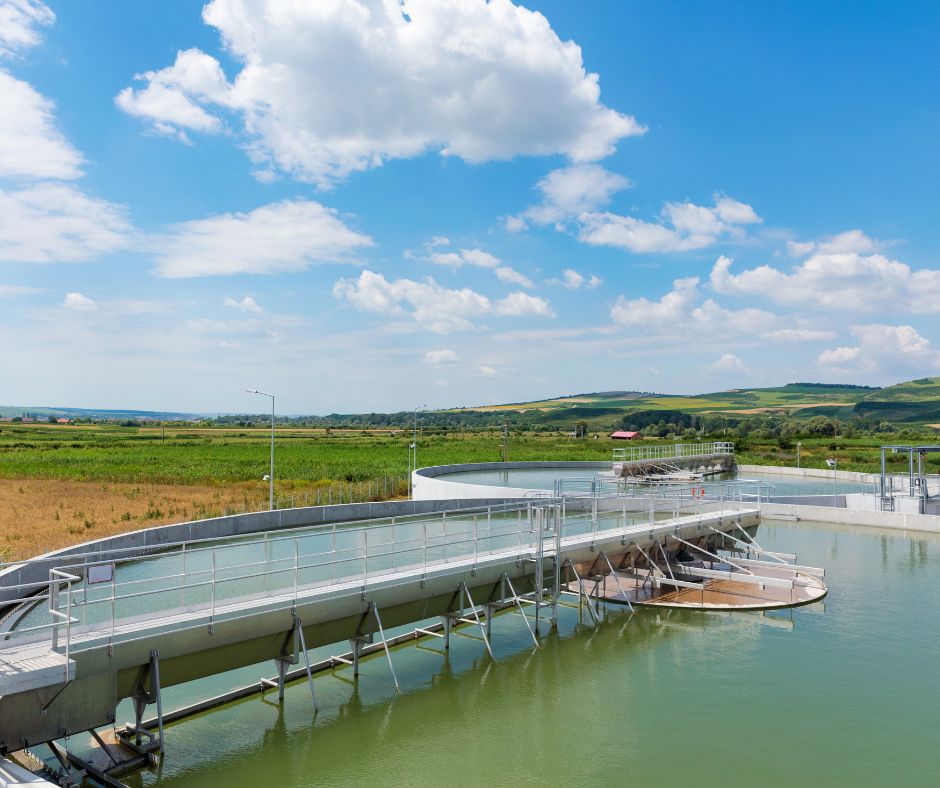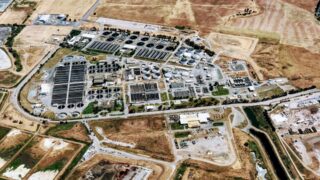Unlocking the Secrets of PFAS Wastewater Treatment
Per- and polyfluoroalkyl substances, or PFAS, have gained notoriety in recent years as persistent, bioaccumulative, and potentially harmful compounds. These synthetic chemicals, often used in manufacturing processes and everyday products, have found their way into our drinking water, waterways and ecosystems, posing a significant threat to the environment and human health. PFAS chemicals have a universal presence in our wastewater systems, stemming from industrial discharges, runoff, and the leaching of consumer products. As a result, municipal wastewater treatment plants across the globe are grappling with the challenge of effectively removing these contaminants from effluent streams.
Plus, traditional wastewater treatment methods are ill-equipped to handle PFAS treatment efficiently, and inadequate PFAS wastewater treatment can lead to the release of these substances into our environment, perpetuating the cycle of contamination.
In this article, we will break down the complexities surrounding PFAS wastewater treatment.
The Role of Wastewater Treatment Plants in Addressing PFAS Contamination
Given the unique properties of PFAS, specialized treatment methods are essential to tackle their presence effectively in wastewater streams. Comprehensive PFAS treatment is a pressing need to prevent the further spread of these contaminants.
For instance, the accurate monitoring and assessment of PFAS concentrations in wastewater are crucial for designing effective treatment strategies. The development of advanced analytical techniques, such as liquid chromatography-mass spectrometry (LC-MS), has enabled researchers to detect and quantify a wide range of PFAS compounds in water samples
Likewise, governments and environmental agencies worldwide have recognized the need to regulate PFAS in wastewater. In the United States, for example, the Environmental Protection Agency (EPA) has issued guidelines and health advisories for specific PFAS compounds.
Traditional Wastewater Treatment Methods and Their Limitations Compared to PFAS Treatment
While traditional wastewater treatment methods have long been the best in purifying water, their limitations become glaringly evident when faced with the formidable challenge of PFAS treatment, underscoring the need for innovative solutions.
Conventional Treatment Techniques
Traditional wastewater treatment processes, while effective for many contaminants, fall short when it comes to PFAS treatment.
Conventional wastewater treatment processes, such as activated sludge and sedimentation, are foundational methods in water purification. However, they are not designed to effectively remove PFAS compounds.
For example, a study done by Das et al, showed PFAS are not easily removed by conventional biological wastewater treatment processes such as activated sludge. In the United States, it was observed that wastewater effluents in North Carolina contained a range of 20 to 4773 nanograms per liter (ng/L) of the sum of 29 different PFAS species.
Inefficient PFAS wastewater treatment can lead to environmental consequences. PFAS compounds may accumulate in sludge, potentially contaminating soil when the sludge is applied as a fertilizer. Additionally, inadequately treated wastewater can release PFAS into receiving waters, harming aquatic ecosystems and wildlife.
Advanced PFAS Wastewater Treatment Technologies
Advancements in PFAS wastewater treatment technologies are offering a glimmer of hope in the battle against persistent PFAS compounds, as new methods promise efficient and thorough removal from wastewater streams.
Activated Carbon Adsorption: A Powerful PFAS Treatment Method
Activated carbon adsorption stands out as a potent and widely recognized method for PFAS wastewater treatment. This technique capitalizes on the remarkable adsorptive properties of activated carbon, which has a high surface area and a strong affinity for PFAS molecules.
Activated carbon works by physically trapping PFAS molecules on its surface through adsorption. The porous structure of activated carbon provides ample binding sites, allowing it to capture a wide range of PFAS species. The ability to selectively remove PFAS from water is a testament to the power of this method.
Granular activated carbon has been proven to remove both PFAS and other organic compounds through adsorption. Plus, GAC can be regenerated and reactivated.
Membrane Filtration PFAS Wastewater Treatment: An Effective Barrier
Membrane filtration techniques, including reverse osmosis and nanofiltration, act as formidable barriers to PFAS contaminants. These membranes function as molecular sieves, allowing water molecules to pass through while obstructing the passage of larger PFAS molecules.
Nanofiltration, in particular, offers precision in PFAS removal by selectively rejecting larger PFAS compounds based on size and charge. This precision allows for efficient PFAS wastewater treatment without significant losses of other essential water constituents.
Ion Exchange Resins: Capturing PFAS Molecules
Ion exchange resins are another formidable tool in the arsenal of PFAS treatment technologies. These resins operate by replacing ions in wastewater with PFAS molecules through ionic bonding.
The selective nature of ion exchange resins enables them to focus specifically on PFAS molecules, making them a valuable asset in targeting these contaminants. Furthermore, their capacity for PFAS wastewater removal ensures prolonged and efficient operation, contributing to their prominence in the PFAS treatment process.
Advanced Oxidation Processes (AOPs): Breaking Down PFAS
Advanced Oxidation Processes (AOPs) offer a different approach to PFAS removal by chemically transforming these compounds into less harmful byproducts.
AOPs utilize strong oxidants, such as ozone or hydroxyl radicals, to initiate chemical reactions that degrade PFAS molecules. This oxidative degradation leads to the dismantling of complex PFAS structures, ultimately rendering them less environmentally harmful.
The Transcend Design Generator is a powerful tool for optimizing PFAS wastewater treatment processes. Using user input and proprietary databases, it conducts process simulations, sizes equipment, and generates essential documentation, ensuring precision and efficiency. To learn more about how the Transcend Design Generator can elevate your PFAS treatment projects, visit our website today.
Emerging Technologies in PFAS Wastewater Treatment

Emerging technologies are harnessing innovation to combat PFAS contamination, offering promising alternatives to traditional approaches.
Electrochemical PFAS Wastewater Treatment: Efficient PFAS Removal
In electrochemical treatment, electrodes are used to apply an electric current to the wastewater. This process can involve various techniques, such as electrocoagulation or electrooxidation. During electrocoagulation, metal ions are generated at the anode, which destabilizes PFAS molecules and causes them to form larger aggregates that can be easily removed through sedimentation or filtration. Electrooxidation, on the other hand, directly breaks down PFAS molecules through oxidation processes.
One of the significant advantages of electrochemical treatment is its efficiency in PFAS removal. It can target a wide range of PFAS compounds, including those that are challenging to remove using traditional methods. However, it’s crucial to consider factors such as the selection of appropriate electrode materials, current density, and reaction time to optimize the process.
Bioremediation: Harnessing Nature’s Capabilities
Bioremediation is a sustainable and eco-friendly approach that harnesses the capabilities of microorganisms to degrade or transform PFAS compounds in wastewater. This emerging technology acknowledges that nature has its own “cleanup crew” that can be employed to mitigate PFAS or forever chemical contamination.
While bioremediation offers an environmentally friendly approach to PFAS wastewater treatment, it’s essential to carefully select the appropriate microbial strains and optimize environmental conditions.
Nanotechnology Applications: A Promising Approach
Nanomaterials, such as carbon nanotubes or graphene oxide, offer a high surface area and tailored surface chemistry that allows them to selectively capture PFAS molecules from wastewater. Additionally, nanocatalysts can be employed in advanced oxidation processes to break down PFAS compounds into less harmful substances.
While nanotechnology holds great potential, it’s important to address challenges such as the potential release of nanoparticles into the environment. Ongoing research is focused on enhancing the stability and safety of nanomaterials for PFAS removal, making this an exciting and evolving area of study.
Hybrid Systems: Combining Techniques for Enhanced Results
Hybrid systems represent an innovative approach to PFAS wastewater treatment by combining multiple techniques to achieve enhanced removal efficiency.
A typical hybrid system may incorporate methods such as activated carbon adsorption, membrane filtration, and advanced oxidation processes. By tailoring the combination of techniques to specific wastewater compositions and PFAS profiles, engineers can achieve optimal results in PFAS treatment.
PFAS Removal Efficiency and Factors Affecting Performance
Understanding the efficiency of PFAS removal methods and the various factors influencing their performance is essential to safeguard our environment from these insidious compounds.
Assessing PFAS Treatment Efficiency
Assessing the efficiency of PFAS removal methods serves as the yardstick by which we gauge their effectiveness. This involves measuring the reduction in PFAS concentrations from influent to effluent, typically expressed as a percentage of removal. Robust assessment methods are essential to determine the success of our treatment strategies.
Impact of Water Chemistry on Removal
Water chemistry plays a significant role in shaping the effectiveness of PFAS removal methods. Factors such as pH, ionic strength, and the presence of competing ions can influence the performance of treatment processes. Understanding these chemical interactions is pivotal in optimizing PFAS removal.
Environmental Fate of PFAS During Wastewater Treatment
Understanding the fate and transport of PFAS compounds in wastewater treatment processes is akin to tracing their trajectory within the system. This involves investigating how PFAS interact with treatment media, whether they partition into sludge, or if they persist throughout the treatment train.
One of the critical aspects of studying the environmental fate of PFAS is assessing the potential for their release into the environment. If treatment processes do not effectively capture or degrade PFAS compounds, they can be discharged into surface waters, and groundwater, or even contribute to soil contamination. This raises environmental concerns that warrant mitigation.
PFAS compounds can bioaccumulate in aquatic organisms, disrupting ecosystems and potentially entering the food chain. It is our responsibility to assess and mitigate these ecological risks through effective treatment strategies.
Monitoring and Analytical Techniques for PFAS Detection
Analytical methods for PFAS analysis require precision and reliability. Techniques such as liquid chromatography-mass spectrometry (LC-MS) and high-performance liquid chromatography (HPLC) are essential tools for quantifying PFAS concentrations accurately. As engineers, our commitment to methodological excellence is paramount in safeguarding water quality.
Real-time monitoring solutions also provide a dynamic view of PFAS concentrations in wastewater. Employing online sensors and immunoassays enables us to access timely data and respond swiftly to contamination events. This capability is pivotal in maintaining water quality and environmental protection.
Summary: A Comprehensive Approach to PFAS Wastewater Treatment
Addressing PFAS contamination in wastewater is a complex and evolving challenge. PFAS compounds’ diversity and persistence require a multifaceted approach that combines advanced treatment technologies, rigorous monitoring, and adherence to regulatory guidelines. Wastewater treatment plants, industries, researchers, and regulatory agencies must collaborate to unlock the secrets of PFAS wastewater treatment and safeguard our environment.
Explore how the Transcend Design Generator can streamline your PFAS wastewater treatment strategies and help you stay ahead in the battle against PFAS contamination.







